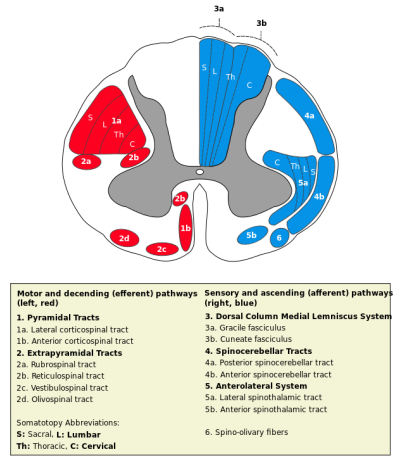Vestibulospinal Tract: Difference between revisions
Kate Sampson (talk | contribs) No edit summary |
Kate Sampson (talk | contribs) No edit summary |
||
| Line 1: | Line 1: | ||
<div class="editorbox"> | <div class="editorbox"> | ||
'''Original Editor '''- <br>[[User:Kate Sampson|Kate Sampson]] | '''Original Editor '''- <br>[[User:Kate Sampson|Kate Sampson]] | ||
'''Top Contributors''' - {{Special:Contributors/{{FULLPAGENAME}}}} | '''Top Contributors''' - {{Special:Contributors/{{FULLPAGENAME}}}} | ||
| Line 6: | Line 6: | ||
== Description == | == Description == | ||
The Vestibulospinal tract is infact made of two tracts, the lateral and medial. Each tract is responsible for increasing antigravity muscle tone in response to the head being tiled to one side <ref name="Fitzgerald">Fitzgerald MJT, Gruener G, Mtui E. Clinical Neuroanatomy and Neuroscience. Fifth Edition. Philadelphia:Elsevier Saunders, 2007</ref> Fibres of the vestibulospinal tracts, the vestibular neuclei, are associated with the cerebellum, which therefore can subsequently result in the cerebellum indirectly influencing control on the spinal control <ref name="Carpenter">Carpenter R, Reddi B. Neurophysiology. A conceptual approach. Fifth edition. London: Hodder Arnold, 2012.</ref> | The Vestibulospinal tract is infact made of two tracts, the lateral and medial. Each tract is responsible for increasing antigravity muscle tone in response to the head being tiled to one side <ref name="Fitzgerald">Fitzgerald MJT, Gruener G, Mtui E. Clinical Neuroanatomy and Neuroscience. Fifth Edition. Philadelphia:Elsevier Saunders, 2007</ref> Fibres of the vestibulospinal tracts, the vestibular neuclei, are associated with the cerebellum, which therefore can subsequently result in the cerebellum indirectly influencing control on the spinal control <ref name="Carpenter">Carpenter R, Reddi B. Neurophysiology. A conceptual approach. Fifth edition. London: Hodder Arnold, 2012.</ref> In addition these pathways recieve information from the labaryrinthine system.<ref name="Crossman" /> | ||
== Anatomy [[Image:Vestibular spinal tract.png|border|right|400px]] == | == Anatomy [[Image:Vestibular spinal tract.png|border|right|400px]] == | ||
| Line 23: | Line 23: | ||
=== Origin === | === Origin === | ||
- Medial and inferior vestibular nuclei<ref name="Fitzgerald" /> | |||
=== Course/ Path === | === Course/ Path === | ||
- Descends bilaterally in the medial longitudinal fasciculus | |||
- Synapses with the excitatory and inhibitory neurons of the cervical spine. <ref name="Fitzgerald" /> | |||
== Function == | == Function == | ||
| Line 32: | Line 38: | ||
- Excitation on extensor motor neurons controlling muscle tone in antigravity postural muscles<ref name="Crossman" /> | - Excitation on extensor motor neurons controlling muscle tone in antigravity postural muscles<ref name="Crossman" /> | ||
- In gait selective activity is notes in the motor neuron of the quadriceps of the leading leg following heel strike and is maintained through stance phase<ref name="Fitzgerald" /> | - In gait selective activity is notes in the motor neuron of the quadriceps of the leading leg following heel strike and is maintained through stance phase<ref name="Fitzgerald" /> | ||
=== Medial Vestibulospinal Tract === | |||
- Head righting relexes. These are responsible for keeping the head and gaze horizontal | |||
- Eye righting reflex. This origniates in the ascending medial longitudinal fasciulus and extends to the extraocular muscles of the eyes. The horizonal position of the eyes when the head is an upright postural set is caused by cancelling of the tonic acitiy of the deiteroocular pathways. <ref name="Fitzgerald" /> | |||
== Pathology<br> == | == Pathology<br> == | ||
Revision as of 22:08, 6 April 2016
Original Editor -
Kate Sampson
Top Contributors - Kate Sampson, Lucinda hampton, Wendy Walker, WikiSysop and Kim Jackson
Description[edit | edit source]
The Vestibulospinal tract is infact made of two tracts, the lateral and medial. Each tract is responsible for increasing antigravity muscle tone in response to the head being tiled to one side [1] Fibres of the vestibulospinal tracts, the vestibular neuclei, are associated with the cerebellum, which therefore can subsequently result in the cerebellum indirectly influencing control on the spinal control [2] In addition these pathways recieve information from the labaryrinthine system.[3]
Anatomy [edit | edit source]
Lateral Vestibulospinal Tract[edit | edit source]
Origin[edit | edit source]
- Lateral vestibular nucleus (Deiters' nucleus) [1]
Course / Path[edit | edit source]
- Fibres descend ipsilaterally though the anterior funiculus of the same side of the spinal cord, synapsing on the extensor antigravity motor neurons.[1][3]
Medial Vestibulospinal Tract[edit | edit source]
Origin[edit | edit source]
- Medial and inferior vestibular nuclei[1]
Course/ Path[edit | edit source]
- Descends bilaterally in the medial longitudinal fasciculus
- Synapses with the excitatory and inhibitory neurons of the cervical spine. [1]
Function[edit | edit source]
Lateral Vestibulospinal Tract[edit | edit source]
- Excitation on extensor motor neurons controlling muscle tone in antigravity postural muscles[3]
- In gait selective activity is notes in the motor neuron of the quadriceps of the leading leg following heel strike and is maintained through stance phase[1]
Medial Vestibulospinal Tract[edit | edit source]
- Head righting relexes. These are responsible for keeping the head and gaze horizontal
- Eye righting reflex. This origniates in the ascending medial longitudinal fasciulus and extends to the extraocular muscles of the eyes. The horizonal position of the eyes when the head is an upright postural set is caused by cancelling of the tonic acitiy of the deiteroocular pathways. [1]
Pathology
[edit | edit source]
Recent Related Research (from Pubmed)[edit | edit source]
Failed to load RSS feed from http://www.ncbi.nlm.nih.gov/entrez/eutils/erss.cgi?rss_guid=1bq4FUNF5-VxzTyGyjz-eh-Ky1lgZ5ciQmb2o-Tya1LzWAUsi4|charset=UTF-8|short|max=10: Error parsing XML for RSS
Resources[edit | edit source]
References[edit | edit source]
References will automatically be added here, see adding references tutorial.
- ↑ 1.0 1.1 1.2 1.3 1.4 1.5 1.6 Fitzgerald MJT, Gruener G, Mtui E. Clinical Neuroanatomy and Neuroscience. Fifth Edition. Philadelphia:Elsevier Saunders, 2007
- ↑ Carpenter R, Reddi B. Neurophysiology. A conceptual approach. Fifth edition. London: Hodder Arnold, 2012.
- ↑ 3.0 3.1 3.2 Crossman AR, Neary D. Neuroanatomy. An illustrated colour text. Third Edition. Philadelphia:Elsevier ,2005







